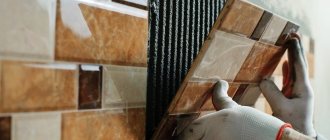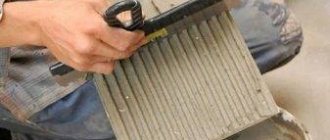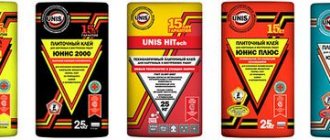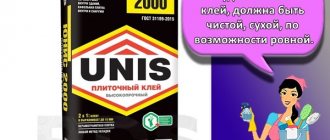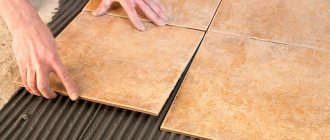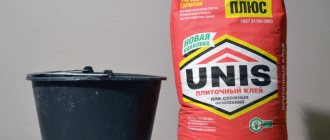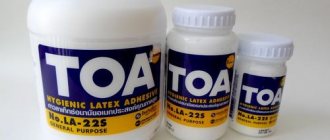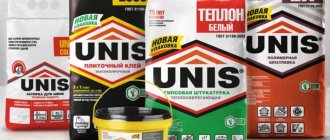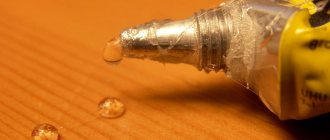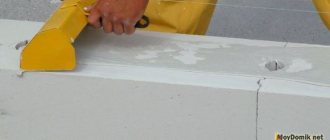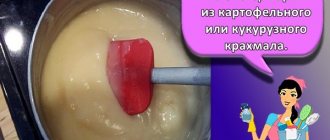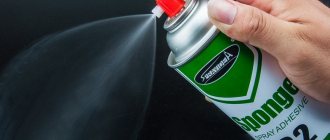The Russian manufacturer of powder adhesive mixtures Yunis began work in the early nineties. The high quality of the products from these manufacturing plants has been recognized by developers and repairmen since the opening of the first one. The well-known nature of the product line is also confirmed by the fact that ordinary Yunis tile adhesive is one of the top three, along with adhesives from Gerkules and Ceresit.
- Where is Unis glue used?
- Features of Eunice glue
- Pros and cons of Unis tile adhesive
- Eunice tile adhesive: types and selection criteria
- Unis HiTech adhesive mixture
- Eunice Belfix mixture
- Tile adhesive Unis Plus
- Unis Fix glue
- Granite Yunis
- Unis 2000
- Unis 21 glue
- Adhesive composition Eunice Pool
- Fast-curing Unis: new
- Unis U-100 Uniflex and U-300 Maxiflex
- How to calculate the consumption of Eunice glue?
- Eunice tile adhesive: step-by-step instructions
- Recommendations for selection and use
This article provides an overview of Unis brand products. We will focus on the different subtypes of this adhesive, their characteristics and specific applications. In addition, we will analyze how to calculate glue consumption and provide detailed guidance on the use of Eunice adhesive materials in practice.
Scope of use
The scope of application of glue is very wide. Yunis is suitable for repair work inside and outside the building, reliably fixing the material to the base.
The safe composition and the absence of a sharp unpleasant odor allows the adhesive solution to be used for cladding medical and children's institutions and houses.
The high level of heat resistance allows you to use Eunice when installing heated floors. Frost resistance makes it possible to lay porcelain stoneware or natural stone on building facades.
Warm glue
The material “Teplokley” is used for external and internal thermal insulation and is intended for fastening mineral and glass wool, expanded polystyrene, and constructing a reinforcing layer. Used for tiles, it can be used to lay ceramics, porcelain stoneware, tiles, and natural stone. Perfect for lining fireplaces and stoves. Characterized by increased elasticity.
It is recommended to work with all adhesive compositions of the Unis brand at ambient temperatures from +5 to +30˚ C. To improve the adhesive properties of surfaces and protect them from moisture and fungus, a deep penetration primer from the same manufacturer is used.
Specifications
The main characteristics of the most popular glue of the Unis Plus series are presented in the table.
| Characteristic | Index | Possibilities |
| Adhesion | 1.25 MPa | Provides strong adhesion to the base not only of tiles, but also of heavier materials such as porcelain stoneware and natural stone |
| Mixture consumption (when applying a layer of 1 mm) | 3.5 kg/m2 | Economical packaging, low material consumption |
| Operating temperature | From – 50 to 70 degrees | High level of heat and frost resistance |
| Usage time | 180 min | It is recommended to dilute in small portions |
| Permissible layer thickness | 15 mm | |
| Drying time | About 24 hours | |
| Work temperature | +5 – +30 degrees | |
| Average installation time | 20 minutes | |
| Weight held | Up to 50 kg/m2 |
Craftsmen without experience in carrying out repair work of this type often make mistakes in choosing the appropriate adhesive solution.
To ensure strong adhesion to the base, it is better to seek advice from a specialist in the store, and also carefully read the characteristics indicated on the product packaging.
How to calculate the consumption of Eunice glue?
Many consumers are concerned about the question of how to determine the consumption of Eunice glue, so as not to make a mistake with its quantity: purchase not enough or, conversely, too many packages. To avoid such a nuisance, you will need to accurately calculate the total coverage area and navigate the thickness of the applied adhesive layer.
In addition, you can simply carefully study the instructions from the manufacturer, which are printed on each package of products. A detailed description will make it possible to correctly calculate the volume of glue needed.
There are also calculators on the Internet that allow you to quickly and effortlessly calculate the required volume of adhesive. To do this, just enter a specific coverage area into the system. Then indicate the type of product used, and the online calculator will give you the estimated cost of glue in kilograms.
Advantages and disadvantages
The main advantages of the Eunice adhesive mixture:
- High level of elasticity, suitable for fixing to a moving base (for example, wood). Fills in all the unevenness.
- Good adhesion, provides strong and reliable adhesion to the base. Allows you to lay it from bottom to top and prevents it from slipping.
- Wide range of applications. Suitable for external and internal work.
- High heat resistance allows the adhesive mixture to be used for heated floor coverings. It does not heat up due to high temperatures, and the fixation does not become worse.
- Dries quickly.
However, it has a number of disadvantages. These include the speed of drying - it will have to be diluted in small portions, which takes a lot of time. If this is not done, it will lose most of its properties, and the master will waste his money.
You might also be interested in watching - Ceresit tile adhesive: varieties and features
Peculiarities
Unis tile adhesive contains cement, chemical components, and mineral additives. It shows all its best sides when temperatures vary from -5 to +30. It is convenient to work with a properly prepared solution; it retains its best properties for 3-5 hours. After application it remains flexible and waterproof.
After installation using this glue, adjustments can be made within 10-20 minutes. Complete hardening of the composition occurs within 24 hours, after which the base can be loaded. Glue from the Yunis company has optimal characteristics for use in a wide variety of conditions. It is only important to choose the appropriate glue for the purpose.
Choice
Unis adhesive is available on the market in several formats, each of which is suitable for a specific type of repair, material, temperature and many other factors. It is always written in the name of the glue or on its packaging what this or that type is suitable for.
Unis Plus
The scope of application of glue is very wide. Eunice Plus is suitable for repair work inside and outside the building, securely fixing it to the base.
The safe composition and the absence of a sharp unpleasant odor allows the adhesive solution to be used for cladding medical and children's institutions and houses.
Basic indicators:
- Adhesion – 1.25 MPa.
- The maximum withstand load is 100 kg/m2.
Scope of application – internal and external cladding, complex bases.
Unis 2000
Allows you to cover floors and walls without prior leveling, and fills unevenness and cracks well.
Withstands ceramic tiles and porcelain stoneware up to 60x60 in size.
Safe and hypoallergenic composition, suitable for use in children's institutions and hospitals.
Unis 21
Typically used for interior wall and floor cladding with standard size ceramic tiles. It is characterized by increased moisture resistance and is used in the renovation of bathrooms and kitchens.
Able to withstand small-sized porcelain stoneware slabs (up to 30x30).
Porcelain tiles with Yunis 21 glue should only be laid on the floor so that they are firmly pressed and the adhesion is strong.
Unis hitech
The Hitech adhesive mixture is highly durable and does not dry as quickly as other types. Allows you to lay it from top to bottom, and not just the standard method - it provides reliable adhesion to surfaces of any type.
Unis granite
From the name of the glue it is clear that its main purpose is to cover walls and floors with heavy materials: natural stone, porcelain stoneware.
Provides tight adhesion and is suitable for laying tiles on floors, walls, plinths, facades.
Dries quickly and prevents tiles from slipping. Adhesion index – 1.5 MPa.
Unis Belfix
Suitable for complex facing work, reliably holds natural stone, marble, granite, mosaic, porcelain stoneware. The main advantages are a high level of elasticity and frost resistance.
Often used for grouting joints, cladding the outside of a building, and decorating heated floors. The most expensive option presented.
For more information about frost-resistant glue, read the article - Frost-resistant glue for external use
Unis fix
Cheap glue that is rarely found in construction stores. In terms of strength characteristics, it is inferior to other types; it is usually used for cladding walls and floors with standard small tiles.
It repels moisture well and is suitable for cladding rooms with high humidity - kitchens, bathrooms.
Unis pool
Suitable for decoration, swimming pools, water tanks with ceramic tiles, mosaics, natural stone. Indoors can be used for cladding with high humidity, heated floors.
New tiles can be laid on old ones; they are also suitable for covering untreated surfaces. Fills cracks and uneven areas well.
Where is Unis glue used?
Eunice glue has a rather limited area of use. For the most part, it is used for laying tile coverings. Moreover, there are special varieties of Eunice products, some types of which are prepared for interior decoration, and the rest are suitable for external finishing work.
Adhesive compositions from the Yunis brand are intended for covering wall and floor surfaces of absolutely all types of tiles of various sizes. As you can see, Unis glue is the optimal choice for any finishing and installation activities. This is evidenced by the recognition of the brand’s products among specialized craftsmen in the field of repair and construction.
Instructions for use
Before use, read the instructions provided on the packaging by the manufacturer. This is especially true for beginners who do not have experience in carrying out facing work. Instructions for use:
- The old surface is removed using a drill or wide spatula. If the wall is painted, you can leave the paint and apply the tiles, first leveling the surface with putty.
- Differences in the base of the surface should not exceed 1 mm per 1 m. Especially deep cracks should be sealed with plaster and covered with soil mortar on top.
- If it is applied to a surface covered with paint, notches are made for every 5 cm of the wall, which increase the level of adhesion of the material to the wall.
- At the end, the surface is well dried and degreased.
Surface preparation
The optimal temperature for facing work is from plus 5 to plus 30 degrees, air humidity should not exceed 75%.
The most difficult thing is to properly prepare the surface. At the same time, it is the preparatory work that largely determines how smoothly the tiles will lie and the appearance of the room as a whole. The base should not only be level, but also strong (it should not fall or crack under the weight of tiles or natural stone), and dry.
The surface on which the glue will be applied should be free of oil stains, paint coatings and various types of contaminants.
When leveling the surface, a deviation of no more than 1 mm per 1 m of surface is allowed - walls, floors, plinths, facades.
Cracks and uneven areas of the wall are leveled using plaster. A thin layer of putty is applied on top to make the surface perfectly smooth. Additionally, cover with a primer mixture to ensure reliable adhesion to the glue.
For cladding surfaces in basements, rooms with high humidity, and swimming pools, apply two layers of primer, drying each one well. It may be necessary to install coating waterproofing.
Before tiling, the tile or base does not need to be additionally moistened with water.
Although, some professionals advise soaking it in water for several hours to ensure better adhesion to the surface.
After installation, excess glue is removed using a spatula. This must be done immediately, since different types of Eunice dry very quickly. Upon completion of the work, grout of a matching or transparent color is applied to it. Residues can also be removed with a spatula or damp sponge.
Mixing the solution
The adhesive solution is mixed in a bucket of water and stirred using a construction mixer.
It is important to comply with all proportions and dosage specified by the manufacturer on the packaging.
Usually the norm is 0.2 liters of water per 1 kg of dry mixture.
If you don't have a mixer, mix it by hand. The amount of glue should be no more than 1 kg, otherwise the mixture will not be homogeneous and it will not fit well. The prepared composition must be applied within 3 hours, otherwise it will begin to dry out and lose its basic properties.
The amount of water must be precise, otherwise the mixture will be too thin.
Applying glue
The application of Eunice glue takes place in several stages:
- First, prepare the surface, seal cracks and irregularities, and cover with a layer of primer. Some types of glue work well on uneven surfaces, but leveling will save some time. This is especially true for beginners.
- It is better to apply the diluted solution with a spatula to make it more convenient to distribute it over the surface.
The thickness of the solution should not exceed 15 mm, otherwise it will begin to “sink” and will not adhere tightly.There is no need to fill the entire wall with glue; you need to apply the mixture to an area that can be covered in 15-20 minutes.
- Within 20 minutes after applying the adhesive, the position of the tiles can be adjusted. It should be clearly leveled.
- It should be applied not only to the wall, but also to the tiles.
Some tips
- Do not spread a lot of glue at once. If you do not have sufficient experience or the tiles are small, knead no more than 5–7 kg at a time. dry mixture;
- When mixing glue by hand, do not dilute more than 2 kg, a larger volume will not allow you to mix all the components evenly;
- To increase the flexibility of the interlocking seam, use additional Eunice elasticizers;
- When covering horizontal surfaces, start from the second row from the bottom;
- When the dry mixture comes into contact with water, an alkaline reaction occurs. Do not allow the solution to come into contact with exposed skin.
We recommend watching the video review:
Spatulas used during work
A lot also depends on the size and type of spatula. To apply the solution, use a spatula of a certain shape. If it is incorrectly selected in size, then the consumption of tile adhesive per 1 m2 increases significantly.
The recommended type of spatula is often indicated on the packaging; in this case, it is better to listen to the manufacturer and purchase it. In addition, it is recommended to adhere to the following rules:
1. Glue consumption directly depends on the angle of inclination of the spatula during application; the greater the inclination, the greater the consumption.
2. The most glue is consumed when applying the solution with a spatula with square teeth; the most economical option is a V-shaped tool.
